What is it about?
With the 1803 Louisiana Purchase, the United States acquired a vast territory of alien terrains that required reinterpretation. The region already contained generations-old narratives conveyed in Native American traditions, but US cultural leaders sought to re-inscribe the land to determine how it fit within, or without, their national domain. Two contending, yet contemporaneous, visions emerged. One described the region as a Great American Desert that would serve as a barrier to future agrarian settlement. The other adorned the Great American Prairie with an emotional and adventurous appeal that would increase in popularity by the late 1840s as the United States neared its moment of “manifest destiny.”
Featured Image

Photo by Yuriy Bogdanov on Unsplash
Why is it important?
Scholars of the North American West often mark clear chronological and interpretive shifts between the concepts of the Great Plains as the inhospitable waste and the bountiful garden and largely dismiss the persistence of the romantic prairie, but one cultural idea rarely displaces another in such neat chronological turns. Instead, the prairie and the desert aspects evolved alongside one another, fluctuating within a spectrum of oppositions. More than a difference of perception or sentiment, the contest between the Great American Desert and the Great American Prairie represented two opposing views of US empire—one that espoused a cautious expansion and the other much more aggressive.
Perspectives
A topic that I could not get to in my book The American Elsewhere (University Press of Kansas, 2017). It further illustrates how culture makers created the justifications for US expansion during the early 19th century.
Jimmy L Bryan
Lamar University
Read the Original
This page is a summary of: “Our Eyes Ached with the Very Vastness”: Reimagining the Great American Desert as the Great American Prairie, Great Plains Quarterly, January 2019, Project Muse,
DOI: 10.1353/gpq.2019.0035.
You can read the full text:
Resources
Contributors
The following have contributed to this page







